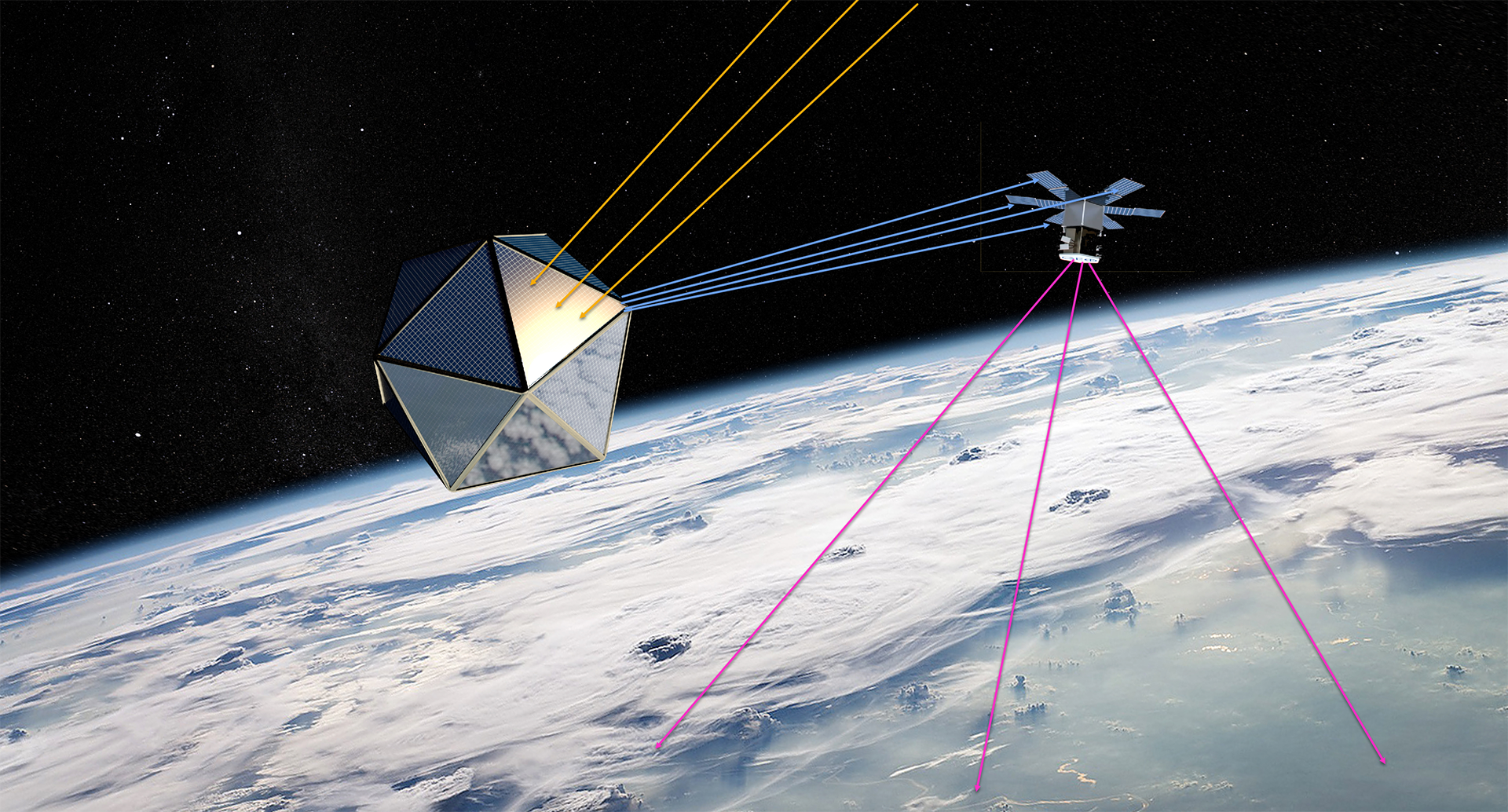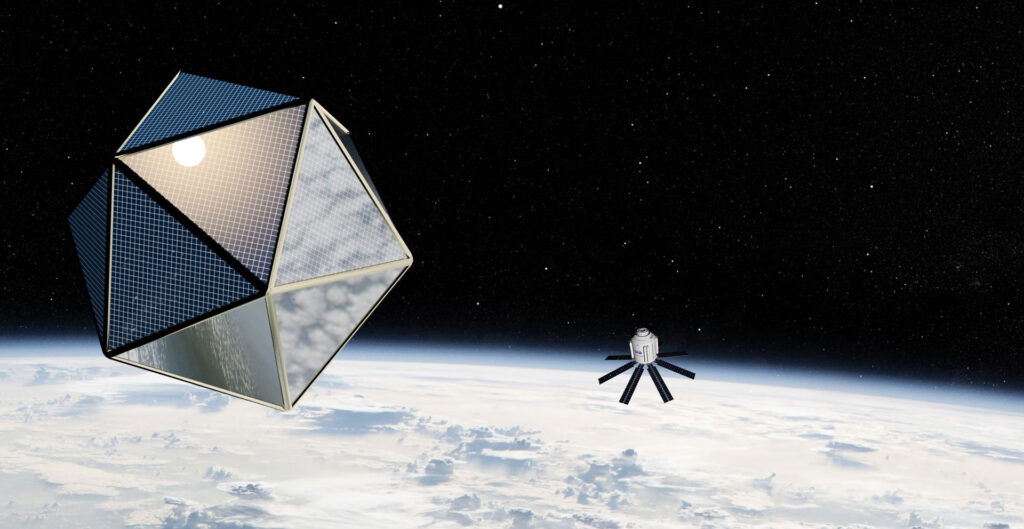SOS - the Space Option Star
Adressing the Energy Dilemma provides the societal context for the development of the Space Option Star (SOS) as an art intervention in orbit. SOS is commonly used as the international Morse code distress signal (· · · – – – · · ·). In popular usage, SOS became associated with such phrases as “save our ship”, “save our souls” and “send out succour” but officially it does not stand for anything specific. In addition to SOS being an acronym for the Space Option Star project, we are using this project to send the message “save our spaceship” with “spaceship” being modern civilization. As all art is fundamentally political and, as the SOS project powerfully conveys a truthful and important message, it should impact the policy discourse related to energy. As an artwork, the Space Option Star will have a more flexible envelope for development than a pure engineering project and will directly involve the public in a variety of ways.
In the mid-1980’s and early1990’s the authors introduced and developed several large scale orbital sculpture concepts. [1] The publicity surrounding our projects and to that of Peter Beck’s Humanity Star launched on January 21, 2018 [2] and to Trevor Paglen’s Orbital Reflector launched on December 3, 2018 [3] exemplifies the novel and controversial aspects of deploying a visible orbital artwork, which indicates that even during the developmental stage, substantial public attention can be focused on the message of such a project.
As such, the SOS has a dual purpose: first, as communication, its mission is to alert and inform the world population about the Energy Dilemma and to call attention to the Space Energy Option and, second, its technical mission represents an early in-situ demonstration of SBSP which should help to justify its development cost.
In 2003, the European Space Agency (ESA) contracted the authors to re-examine the technology for large expandable structures in light of any new technological developments for the purpose of celebrating the 2016 Winter Olympics. [4] Our study included the examination in some technical detail of a large icosahedron to be built utilizing the chemically rigidized expandable structures (CRES) technology that had been under development in the United States and in Europe for over thirty years, although not yet used for a space structure of this dimension. [5] [6] In 2008, the idea of incorporating space solar power elements and other interactive technologies was introduced.
The space segment of the SOS project would perform an early demonstration of the basic technological elements of SBSP. Electricity generated by the icosahedron's solar arrays would flow to co-located microwave transmitters to beam power toward a companion spacecraft, which will then use it to transmit video and other interactive communications from orbit to public locations around the world such as art and science museums and schools.

Space Option Star in situ space solar power demonstration
Initial Technical Considerations
The suggested configuration of the SOS project elements builds upon a variety of studies (of similar aim) and technological concepts. For instance, the “power satellite” requires a (relatively) large size to collect sufficient solar power and to support a representative high-gain transmitter, as will be the case for operational items. On the other hand, in order to reduce costs, simplified designs are preferred. Here, the icosahedron geometry approximates an omnidirectional object, with the Sun illuminating similar surface areas at any given time, thus removing the need for an (active) attitude control system. Similarly, array antennas can track the receiver's position electronically, eliminating dedicated steering mechanisms.
The choice of this geometry is further supported by various factors, beginning with its classical simplicity: As one of the five Platonic solids, it is composed of 20 triangular facets, with 30 sides and 12 vertices. Vertices and sides are realized as nodes and tubular struts that form a skeleton supporting the membrane-like facets. As the satellite tumbles, the flat triangle's surfaces will reflect sunlight causing it to appear in the night sky as a blinking star. This way, the SOS would be visible to much of the world’s population during its limited orbital lifetime.
The above-mentioned study looked at the size, the mass, and the visibility of such an icosahedron with a 100 meter extension. It was determined that such a “star” would reach a magnitude of about -4.4 (which would correspond to Venus at its brightest), with orbits that allow a lifetime of approximately 30 days. Indeed, an 85-m sphere ought to reach -4.4 in magnitude at a slant range from a 760-km orbit; an equivalent icosahedron's lifetime estimate comes to some 24 days.
An icosahedron equivalent to an 85-m sphere ought to reach a magnitude of -4. at a slant range from a 760-km orbit, with an orbital lifetime estimated at some 24 days. As the object's orbit decays, it will become more brilliant, as suggested in the figure below.

Orbital characteristics of the Space Option Star
For reference to an actual object that is easily visible to the naked eye, one could compare the SOS to the International Space Station (ISS): 52 m long, 27.4 m high and 73 m wide. Due to its irregular shape and position relative to the horizon the observed magnitude of the ISS varies considerably. The SOS would be much larger and much brighter and, as with all orbital artworks, objections from astronomers are to be expected.
The Space Option Star art intervention is an interdisciplinary, multi-dimensional art, science, technology and educational project designed to inform and excite the world population about the importance and urgency of implementing the Space Option and the many advantages of using space technology to meet some of the growing essential needs of the humanity as well being an example of the inherent commercial opportunities involved in space development.

Preliminary visualization of the Space Option Star in the sky.
The artist and the community are profoundly interrelated. Traditionally, artists have been channels for the tempo, the tone and the intensity of their society and throughout history, art has served as a means to make complex issues more comprehensible. The novelty of placing a large scale artwork in Earth orbit – one that would be visible to much of the world’s population - would effectively and economically serve as a global communication opportunity. As such, the media and political attention before, during and after the event would significantly enhance both the awareness and the discussion of developing the territories of Greater Earth and implementing the Space Option concept throughout all cultures around the world
References:
- Arthur R. Woods & Marco C. Bernasconi, 1991, The Orbiting Unification Ring-Space Peace Sculptures: Progress Report on Global Art In Space, Paper IAA-90-652 presented to the 41st IAF Congress, Dresden, Germany. October 6-12. Published in LEONARDO 24, [5] pp. 601-606
- Rocket Lab defends Humanity Star launch, Otago Daily Times, 27 January 2018
https://www.odt.co.nz/news/national/rocket-lab-defends-humanity-star-launch
Accessed 10.3.2020 - Trevor Paglen, Orbital Reflector, Nevada Museum of Art
https://www.orbitalreflector.com Accessed 10.3.2020 - ESA Contract No.16188/02/NL/MV, The OURS Foundation.
- Marco C. Bernasconi & Arthur R. Woods, 2009 , Lights in the Sky: Membrane Structures for Art in Space, International Conference on Textile Composites and Inflatable Structures, Structural Membranes 2009, E. Oñate, and B. Kröplin, (Eds) © CIMNE, Barcelona, Spain
https://thespaceoption.com/publications/Lights_in_the_sky_PPH-09-078-1.pdf
Accessed 10.3.2020 - M.C. Bernasconi Consultants, Chemically Rigidized Expandable Structures, https://spaceoptionstar.space/chemically_rigidized_expandable_structures_mcbc.php Accessed 10.3.2020
Frequently Asked Questions:
-
What is the Space Option Star?
The Space Option Star will utilize an inflatable laminated membrane technology incorporating a thin-film photovoltaic outer surface. Once in orbit, the reflective, faceted shape of the Space Option Star will reflect sunlight as it rotates causing it to appear as a blinking star in the night sky for a period of approximately one month or longer. In addition to the visibility aspects which will make Space Option Star a significant global art work available to much of the world’s population, interactive components will enable communication with Space Option Star at public locations around the world such as art and science museums and schools.The technical mission of the Space Option Star will be to collect sunlight, transform sunlight into energy and then to transmit this energy via a concentrated beam to provide power for an auxiliary, unattached object in orbit which will then use this power to communicate with locations on the Earth. -
What is the purpose of the Space Option Star mission?
The Space Option Star has two main objectives: First, it is an art intervention with a potential to communicate a powerful message designed to alert and inform the world population to the Space Option concept as the most optimistic choice which can be made by humanity about its future.Second, it is destined to become an early insitu demonstration of Space Solar Power which is a key element in the Space Option concept. -
Will the Space Option Star beam energy to Earth?
No, the SOS will collect energy in space and use a microwave transmitter to convert the sunlight into electricity and then transmit electrical power to an auxiliary spacecraft which will use the received power to interactively communicate with stations located on Earth. As such, it will be an early “in space” or insitu demonstration of the basic technological concepts of Space Solar Power. -
What is the value of this demonstration?
If realized within the next decade, the SOS will probably be the largest structure ever deployed or built in outer space, and, that it will be visible to much of the world’s population, will make SOS an unprecedented global art work and space event.In addition, the interactive communication from the spacecraft to locations on Earth will involve people from around will be highly educational.Last but not least, the art funding approach will allow the world population to personally share in its realization.If successful, this mission could stimulate further development in the Space Based Solar Power technology which could eventually help address energy and climate issues on Earth.There exists a big commercial potential to supply satellites and space stations with electrical power instead of each spacecraft having its own solar power collectors. This could reduce to overall cost of producing spacecraft while increasing their reliability. -
How can Space Solar Power realistically contribute to addressing humanity’s energy and climate issues?
Solar power does not produce CO2. Harnessing solar energy in space would replace humanity’s dependence on its continued use of finite fossil fuels which are also environmentally negative and likewise, on the widespread use of brown coal and/or nuclear fuels which have grave environmental and geopolitical aspects. Unfortunately, it appears that alternative and renewable terrestrial energy resources, while both desirable and necessary, may never be economically deployed on a scale sufficient to meet the growing needs and demands of present and future populations. -
Why is it called a “star” and will it be visible to observers on Earth?
As presently defined, the SOS will have a circumference of approximately 100 meters and will be a highly reflective spherical object. Its rotation will reflect sunlight in a blinking fashion. In comparison, the International Space station - which is not a solid object - is approximately 52 m long, 27 m high and 73 m wide and is easily visible to the naked eye. -
Why is the Space Option Star being developed as an art intervention and not as a typical commercial or scientific mission?
We believe the Space Option message is critical to the future of humanity and this aspect of the project will begin as the project becomes more publicized and will be fully achieved when the SOS is visible as a star in the sky.As an art intervention, the project has a wider technological developmental framework in which to achieve its goals. As such, it is more flexible and perhaps less risky than a typical scientific or commercial space mission with similar technological objectives. -
Is the Space Option Star technologically feasible?
The underlying technology of using CRES (Chemically Rigidized Expandable Structures) for large space structures has been under development in Europe and in the United Stated for almost thirty years, although not yet used for a space object of this dimension. The authors have a long experience with proposing artworks based on this technology and carried out a study sponsored by the European Space Agency in 2003 that provided a basis for the current technological SOS (icosahedron) definition. A number of international studies and experiments have explored the idea of power generation in space and the wireless transmission of power. -
How much will the Space Option Star cost?
The actual cost of the mission can only be determined once additional technical studies have been carried out. These are part of the project’s development plan. At the moment, the Space Option Star will have an estimated mass of 3,500 kilograms, a main cost factor will be the actual launch costs. Recent developments have seen a reduction in launch costs.Based on our best estimates and experience we believe the project could be realized for 20 -25 million Swiss francs (Swiss francs are approximately equivalent to US dollars). -
How will the Space Option Star be financed?
As with our previous art interventions, we plan to rely primarily on an art funding (crowdfunding) approach. Art works specific to the Space Option Star will be created and sold to people who want to support the project. Hopefully millions of people will want to support this and other Greater.Earth art interventions.A good example of multi-million dollar artist funded projects have been those undertaken by Christo and Jean-Claude - i.e. the Wrapped Reichstag (1971-1995) which cost $15,000,000 to realize and was financed solely through the sales of artworks made by the artists.In today’s art market, artworks costing much more are regularly sold in art galleries, art fairs and in auctions. Perhaps some art collector will wish to purchase the Space Option Star before or while it is in orbit.

